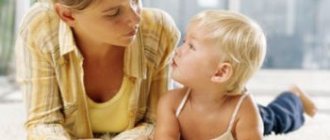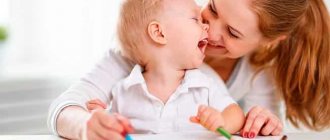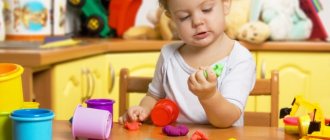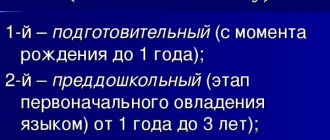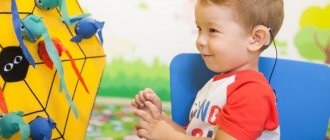09/06/2015, Games for speech development, Articles No comments
At 2 years old, your child has already become a completely independent person. He can assemble a pyramid, build a tower of cubes, and bring spoons to the table before dinner. He even tries to dress and undress himself, wash himself, and use a comb and toothbrush. Day after day he repeats the same actions and improves in them. The baby watches you with pleasure and imitates you enthusiastically.
Imitates, among other things, adult speech. Therefore, parents of two-year-olds should make efforts in several directions in the development of children’s speech at once, and it is better to do this through play.
Games and exercises for training the muscles of the articulatory apparatus
The pronunciation side of the speech of 2-3 year old children is still far from perfect. Having begun to use active speech, children train their articulatory apparatus. You can use special exercises to develop movements of the tongue, lips, and lower jaw. With their help, the muscles of the articulation organs are strengthened, and sounds appear faster and sound more clearly. All these exercises are carried out in a playful way, always with demonstration of movements. The child should sit in front of the mirror.
Lip exercises
“The bubble has burst” - puff out your cheeks, and then press one or the other with your finger.
“The bunny was mistaken for a wolf” - stretch out your lips and quickly smile, showing your teeth.
“Stop the horse” - say “Whoa!”
“Show how a kitten laps milk” - make quick movements with your tongue: stick out and hide your tongue.
“Needle” - touch the tip of your tongue to the inner surfaces of your cheeks.
“The horse clicks its hoof” - click your tongue, raising it to the upper palate.
Exercise for the lower jaw
“The gate is open” - open and close your mouth wide.
Speech development in young children
Speech development in young children occurs in stages. Each stage corresponds to certain active (pronounced) and passive (understood) dictionaries and sound pronunciation.
Child 2-3 years old
Early speech development of a child
By the age of 3, the baby has formed a certain “base” of speech, on the basis of which all further development is built. Therefore, from birth, you need to pay special attention to the development of the child’s speech skills.
Average standards
If from the first months of life the child was actively engaged at home, communicating and commenting on their and his actions, then by the age of 2-3 years he has developed a fairly large passive vocabulary. At the same time, he can speak indistinctly, incomprehensibly, in abrupt words and short phrases.
Note. During this period, understanding of speech is more developed than its pronunciation.
Basic norms for the development of a baby’s speech by the third year of life:
- Most of the words used are nouns and verbs. Begins to use adjectives, prepositions and conjunctions, pronouns and adverbs.
- Simple phrases of 2-3 words are used. Able to support simple dialogue.
- Knows the characteristics of an object (large, small), basic colors and shapes.
- Understands an adult's address to him.
- A form of active language learning is the invention of new words. For example, a shoulder blade can be given a name - a digger.
- Sound pronunciation by the age of 3 is far from ideal. Difficulties arise when pronouncing whistling and hissing sounds, “L” and “R”. Hard ones are often replaced with soft ones. This is considered the norm for this age; clear sound pronunciation develops by the age of 5.
The main causes of delayed speech development in children
Sometimes the process of speech activity does not develop according to the generally accepted scenario. Due to his age, it is high time for the baby to speak, but he stubbornly remains silent, communicates through facial expressions and gestures, or is extremely illegible. The causes of speech development delay (SDD) may be the following:
- Mother's illnesses during pregnancy;
- Birth injuries;
- Previous illnesses and head injuries of a child under three years of age;
- Hearing impairment;
- Lack of intensive communication with adults.
Breathing exercises and articulation gymnastics
Breathing exercises are performed under several conditions: the child sits with a straight back, looks straight ahead, and does not puff out his cheeks when exhaling. You can do breathing and articulation gymnastics at home, and you can complete the materials for the exercises in the process of joint creativity with your child.
Note. Articulatory gymnastics at this age occurs by imitation of an adult, mostly in front of a mirror.
What could be the reason for the baby’s silence?
The reasons for the baby's silence may be:
- little attention from adults;
- trauma during the perinatal period and early childhood;
- hearing impairment.
Many parents refer to the fact that “the relative spoke at 4, and everything is fine with him.” However, it is worth remembering that it is worth developing a child’s speech from an early age, because heredity does not play a dominant role in its development, and the consequences can be very dire. Motor and sensory alalia, mental retardation and other speech disorders require constant speech therapy correction.
Speech therapy classes for children at home
What affects speech development in a two-year-old child?
Primarily influenced by heredity and the presence of injuries during pregnancy, childbirth and during the early development of the baby.
The second reason is the environment. It is important that you communicate with the child often and correctly (without babying). Children's words and phrases at this age are an accurate reflection of the speech of adults. Therefore, in order to properly develop and enrich a child’s vocabulary, you need to carefully monitor the speech environment in which he is located.
Homework with a child
Deviations in speech development
When a child is at an early age, it can be difficult for parents to notice any irregularities in his speech, however, the alarm should be sounded if:
- Throughout the months from two to three years, the baby’s vocabulary did not develop, or was replenished with only a few words.
- The child does not understand speech addressed to him (preconditions for sensory alalia).
- Speech understanding is present, the passive vocabulary increases, but does not become active, the child does not speak. This may be an indicator of motor alalia or other speech disorders.
- The baby does not pronounce a large number of sounds correctly. At this age, you can still “turn a blind eye” to shortcomings in the pronunciation of some hissing and whistling sounds, as well as the sound “P”, but if there are defects in the structure of the speech apparatus, then a general underdevelopment of speech will be observed. As a result, mental development as a whole is “slowed down” and indicators of the level of formation of thinking, attention, and perception decrease.
- He speaks in a “bird” language, more like long babbling chains. This is acceptable when the child is still one year old, but not when he is two. In non-verbal children, mooing may occur.
In any of these cases, speech therapy classes will be recommended for children from 2 to 3 years old.
Causes and mechanisms of development of disorders
Deviations during the development of speech can be observed in children with:
- SRD (speech development delay). A delay may occur due to pedagogical neglect, when the child is not engaged, talked, played, etc. Premature birth is also often the cause: fetal development, which continues in the last months of the intrauterine period, in this case occurs in the first months life of a newborn, which is why developmental delays may occur.
- Alalia. The cause of alalia may be disturbances in the functioning of the speech centers of the cerebral cortex, postpartum head injuries, and complications of pregnancy in the first trimester.
- Speech negativism. In speech therapy, this concept implies denial, unwillingness to make contact. Here we are talking about the norm of development as a whole, it’s just that in some situations children may, for various reasons, refuse to repeat or answer questions. However, there are cases when a child suffered stress in early childhood, associated, for example, with fear, and there are also more serious reasons, for example, psychological trauma. The child's psyche is weakened, and refusal to speak will be one of its defensive reactions. In such cases, you cannot do without working with a psychologist.
If children are raised in a multilingual home, there is also a chance that speech development will be delayed.
Speech games for children 3-4 years old card index on speech development (junior group) on the topic
Games for the development of sound culture of speech
“What does it sound like? »
Goal: Continue to learn to isolate and recognize the sounds of individual musical instruments.
Procedure: The teacher shows musical instruments one by one and demonstrates how they sound. Then the teacher offers to solve riddles. He closes the screen and acts with different instruments, and the children recognize what different sounds belong to.
“What does it sound like?”
Goal: To introduce children to the sounds of the world around them, teach them to isolate and recognize them.
Progress: The teacher shows the objects one by one and demonstrates how they sound. Then the teacher offers to solve riddles. He closes the screen and acts with different objects, and the children recognize which objects the different sounds belong to. Explains that there are many sounds in the world and they all sound differently.
Game "Loud - Quiet"
Target. Teach children to correlate the nature of their actions with the sound of the tambourine. Developing children's ability to switch auditory attention.
Preparatory work. Prepare 2 flags for each child.
Progress: Children sit in a semicircle. Each person has 2 flags in their hands. If the teacher rings the tambourine loudly, the children raise the flags up and wave them; if quietly, they keep their hands on their knees.
Methodical instructions. An adult needs to monitor the correct posture of children and the correct execution of movements; It is necessary to alternate the loud and quiet sound of the tambourine no more than four times so that children can easily perform the movements.
"Loud quiet"
Target. Teach children to change the strength of their voice: speak loudly, then quietly. Developing the ability to change the strength of your voice.
Preparatory work. The teacher selects paired toys of different sizes: large and small cars, large and small drums, large and small pipes.
Progress: An adult shows 2 cars and says: “When a big car drives, it makes a loud signal: “beep.” How does a big car signal? Children say loudly: “Bee-Bee.” The teacher continues: “And the small car beeps quietly: “beep.” How does a small car honk? Children quietly say: “Bee-Bee.” The teacher removes both cars and says: “Now be careful. As soon as the car starts moving, you must give a horn, make no mistake, a big car honks loudly, and a small car honks quietly.”
The rest of the toys are played in the same way.
Methodical instructions. Depending on the number of children in the group, you can use one pair of toys or 2-3. Make sure that when pronouncing onomatopoeia quietly, children do not whisper.
Leaf fall (the game “Blow a Feather” is played in a similar way) Purpose: learning to exhale smoothly, freely; activation of the labial muscles. Equipment: yellow, red, orange leaves cut out of thin double-sided colored paper; bucket. Progress of the game: The teacher lays out leaves on the table and reminds the children about autumn. - Imagine that it is autumn now. Red, yellow, orange leaves fall from the trees. The wind blew and scattered all the leaves on the ground! Let's make a wind - let's blow on the leaves! The adult and the children blow on the leaves until all the leaves are on the floor. In this case, it is necessary to ensure that oral exhalation is carried out correctly, as well as to ensure that children do not become overtired. - All the leaves on the ground... Let's collect the leaves in a bucket. The teacher and children collect leaves. Then the game repeats again.
Feather, fly!
Target:
development of strong smooth directed exhalation;
activation of the labial muscles. Equipment:
bird feather.
How to play:
Throw the feather up and blow on it without letting it fall down. Then offer to blow on the child. Pay his attention to the fact that you need to blow hard, directing the stream of air towards the feather from bottom to top.
Snowflakes are flying
Goal: formation of a smooth long exhalation; activation of the labial muscles. Equipment: pieces of cotton wool. How to play: An adult places pieces of cotton wool on the table and reminds the children about winter. — Imagine that it is winter now. Snow is falling outside. Let's blow on snowflakes! An adult shows how to blow on cotton wool, the children repeat. Then everyone raises the cotton wool and the game is repeated again.
"Butterfly, fly!"
Target. Achieve long, continuous oral exhalation.
Preparatory work. Prepare 5 brightly colored paper butterflies. Tie a thread 50 cm long to each and attach them to the cord at a distance of 35 cm from each other. Pull the cord between two posts so that the butterflies hang at the level of the standing child’s face.
Progress: Children sit on chairs. The adult says: “Children, look how beautiful the butterflies are: blue, yellow, red! There are so many of them! They look like they're alive! Let's see if they can fly. (Blows on them.) Look, they flew. Try to blow too. Who will fly further? The adult invites the children to stand one by one next to each butterfly. Children blow on butterflies.
Methodical instructions. The game is repeated several times, each time with a new group of children. It is necessary to ensure that children stand straight and do not raise their shoulders when inhaling. You should only blow on one exhalation, without drawing in air. Do not puff out your cheeks, move your lips slightly forward. Each child can blow for no more than ten seconds with pauses, otherwise he may become dizzy.
Sounds around us.
Goal: development of correct speech breathing - singing the vowel sounds A, O, U, Y in one exhalation.
Progress of the game: The teacher invites the children to play this game.
– In the world around us we hear a variety of sounds. How does a baby cry? “A-A-A!” How does a little bear sigh when his tooth hurts? "OOO!" The plane in the sky hums: “U-U-U!” And the steamboat on the river hums: “Y-Y-Y”! Repeat after me.
The teacher draws the children’s attention to the fact that each sound should be pronounced for a long time, on one exhalation.
Snake.
Goal: development of correct speech breathing - prolonged pronunciation of the consonant sound Sh on one exhalation.
How to play: Invite the kids to play with snakes. The game is played on the carpet.
- Let's play snakes! The snakes have come out of their holes and are basking in the sun. The snakes hiss: “SH-SH-SH!”
Remind children to take a deep breath and hiss for a long time. During prolonged pronunciation of the sound Ш, you cannot take in air.
Pump.
Goal: development of correct speech breathing - long pronunciation of the consonant sound C on one exhalation.
How to play: Invite the kids to play pumps. The game is played on the floor and is accompanied by movements that simulate inflating a wheel using a pump.
– Which of you likes to ride a bicycle? What about by car? Everyone loves it. But sometimes the wheels of cars and bicycles get punctured and deflate. Let's take the pumps and pump up the tires - like this! “S-S-S” – the pumps are running!
The teacher shows the movements of the pump and explains that you should inhale more air while the pump is running, and then gradually exhale it smoothly, pronouncing the sound C. You cannot take in air while pronouncing the sound. The pump can continue to operate after a pause when the child takes another breath. It is necessary to ensure that children do not overexert themselves while playing.
Deflate the balloon.
Goal: development of correct speech breathing - prolonged pronunciation of the consonant sound F on one exhalation.
How to play: Invite the kids to play this game: standing on the carpet, spread your arms wide to the sides - you get a ball, then pronounce the sound F for a long time, while simultaneously bringing your hands in front of you - the ball deflates. At the end, hug yourself by the shoulders - the balloon has deflated.
- Let's play marbles! Spread your arms to the sides - like this! These are how big the balls turned out. Suddenly a small hole appeared in the balloon, and it began to deflate... Air comes out of the balloon: F-F-F! The balloon is deflated!
Remind the children to inhale more air while the balloon is inflated, and then gradually exhale it smoothly, making the sound F. Do not suck in air.
Games for developing grammatical structure of speech
What's missing?
Purpose: To practice the formation of genitive plural forms of nouns.
Material: Pairs of objects: nesting dolls, pyramids (large and small), ribbons (of different colors and different sizes - long and short), horses, ducklings (any toys), Parsley, bag.
Progress of the game: Parsley appears in front of the children with a bag. He says that he brought toys for the guys. Children look at toys. They call them. They put it on the table.
- Remember what objects are on the table. There are pyramids, nesting dolls, and ducklings. Parsley will play with you. He will hide toys, and you will have to say which toys are missing: nesting dolls, pyramids, ducklings or something else.
Three pairs of objects remain on the table: nesting dolls, pyramids, horses. Children close their eyes. We hide the nesting dolls and put ribbons in their place. (“Who’s missing?”) Then we hide the ribbons and put pyramids in their place. (“What’s missing?”) Etc. Finally, we remove all the toys and ask: “Which toys are missing?”
"What's missing"
Purpose: to teach children to form genitive nouns
singular
Equipment: plot picture, color pictures in any quantity.
Progress of the game:
Option 1. An adult and a child play.
In front of the child is a picture with a plot, for example, “Visiting Cheburashka.” The fairy-tale hero Ant comes to visit Cheburashka with gifts. The child places gifts around the room. The child lists them and examines them. Then the child is given time to memorize. After this, it is suggested that the child close his eyes. At this time, the adult removes one picture or turns it upside down. Asks the child the question: “What’s missing? " The child opens his eyes, looks at it and answers, for example: “There are no currants,” and so on.
Option 2. Child-child.
The principle of the game is the same. Only two children are playing. Everyone takes turns being the leader. One child closes his eyes, the second hides the picture. And vice versa, they change roles. Children find it very interesting to guess and hide pictures. The game is fast and entertaining.
"One is many"
Goal: Learn to use singular and plural nouns.
Equipment: cards depicting objects in the singular and plural.
Procedure: Children have cards with the image of one object and many objects.
1. The children’s task is to name what is in the picture. Sample: I have one cube and many cubes.
2. Change the words so that they mean many things. Sample: ball - balls, cube - cubes.
3. Change the words so that they mean one thing. Example: trees - tree, ducklings - duckling.
"Wonderful bag"
Purpose: During the game, children learn to determine what kind of object it is by its characteristic external features, that is, by its shape. It can also be used to develop speech and imagination.
Equipment: Opaque bag. For kids it is recommended to sew it from bright fabrics (to increase interest in what is happening), and for older children - from dark fabrics.
Items. They should follow a specific theme (vegetables, geometric shapes, animals, letters or numbers) and have distinct differences in shape.
Progress of the game. The meaning of the game is very simple: you need to put your hand in the bag, feel for the object and name it, without seeing what it is specifically. To prevent children from getting confused, you can first put 1 object, and then, when they learn to play like this, several more.
In addition to the main task, players may be given additional ones:
- describe the object you come across (color, size, taste, material) or animal (what it does, where it lives);
- tell what fairy tale this object or hero is from;
- describe it so that other children can guess it;
- name words starting with a given letter;
For very young children, you can offer this way to choose a toy with which he will then play. To do this, they are first shown the objects that are placed in the bag, and then each one in turn takes out his own.
What is where?
Goals:
- consolidate knowledge of the need to maintain order in the group;
— clarify knowledge about the arrangement of objects in a group;
- reinforce the idea that keeping things in order helps maintain health.
Equipment: subject pictures depicting toys, dishes, clothes, shoes, books, photographs of group furniture, play areas and other areas by type of children's activities.
Contents of the game.
The teacher reviews with the children photographs of group furniture and areas by type of activity, and clarifies their purpose. He lays out photographs on the tables, distributes object pictures to the children and offers to put things in order - to put objects in their places.
"Help me find my mom"
Goal: to teach to distinguish and name animals and their young, poultry and their chicks. Reinforce the correct pronunciation of sounds. Develop intonation expressiveness.
Equipment: pictures depicting animals and their young, birds and their chicks
Move: Try to show, for example, a mother - a dog and offer to choose from two options - a puppy and a gosling, for example, whose mother is it and vice versa. Gradually add more and more animals.
All children have object pictures with baby animals. Educator: “Who is your picture, Kolya? (chicken) Who is the chicken's mother? (chicken). Call your mother, chicken, (pee-pee-pee). The teacher imitates the clucking of a chicken.
Educator: This is a goat (showing a picture). How is she screaming? Who is her cub? How does he scream? This is a sheep (show picture). How does she bleat? And how does her baby lamb scream? etc.
The teacher hands out pictures of animals and birds to the children. The kids are walking (children leave the tables), they are nibbling grass, nibbling crumbs. Whose mother or whose father will call the cub. He must shout - answer them - and run - put the picture next to them. The children ran to their mothers.
The teacher pronounces the cry of an animal or bird. The child who has a picture of a baby or chick pronounces sounds and puts up a picture.
With older children, you can turn all the cards over to the other side and offer to open two cards in turn; whoever makes the most pairs of animals first and names them wins.
Equipment: pictures depicting animals and their young.
Games to expand and activate vocabulary
"Who is this? What is this?"
Goal: Name words denoting animate and inanimate nouns.
Equipment: pictures depicting objects, animals, people, birds.
Progress: The teacher explains to the children that all objects have their own names and names different objects. There are many objects around us. And you can ask about each of them. I will ask you, and you will answer in one word: “What is this?” Points to a picture of an inanimate object or to the object itself. Children name objects. Shows an animate object or picture and asks: “Who is this?”
2. Look at the pictures. Name those that represent living (non-living) objects. Ask them a question.
3. The teacher names words randomly, denoting animate and inanimate objects. Children ask them questions: an apple - “what is it?”, a dog - “who is it?”
"Who's doing what?"
Purpose: To introduce words denoting action. Learn to use verbs in speech and ask questions to them correctly.
Equipment: pictures depicting various actions.
Progress: The teacher shows children different plots. Children ask questions or name an action.
1. The child is asked to name what the person (animal) is doing in the picture.
2. Several pictures are laid out on the table. The child is asked to find the given action. Find a picture of a girl jumping. What is the girl doing?
"Call me kindly"
Purpose: To introduce the structure of words in the process of forming nouns with diminutive suffixes.
Equipment: pictures depicting objects of different sizes.
Progress: The teacher explains to the children that they will play “affectionate names.”
They danced in a circle, they were affectionate,
They called me into the circle and called me my name.
Come out, Lenochka, to the circle!
Take the flag, Helen.
Children call the child's name affectionately, passing the flag to the child standing next to him.
Children are given pictures depicting large and small objects. Name the objects according to the example: table - table.
"Parts of the Day"
Goal: to create conditions for children to master the concepts of “Morning”, “Day”, “Evening”, “Night” and their correct sequence.
We usually play the game in the morning, on the carpet. As additional stimulus material, pictures were made depicting the activities of children at different times of the day (night - the baby is sleeping, morning - the baby is washing, stretching or doing exercises, day - the baby is playing or walking, evening - playing at home or going home with mom).
We start the game with the question: When do we sleep? (after the children’s answers, the first child receives the picture “Night” and puts it on himself).
We continue: When NIGHT ends, MORNING comes. We wake up, stretch, wash ourselves (accompanied by appropriate movements) and go to kindergarten. (The second child receives the picture “Morning” and puts it on himself). IN THE DAY, all the guys play (clap their hands) and walk (stomp their feet). (The third child receives the picture “Day” and puts it on himself) Well, in the EVENING, all the kids run to mom! (children open their arms to hug). Then NIGHT comes again (children put their palms under their cheeks and close their eyes for a while). When children have learned to identify parts of the day from pictures and correctly perform the corresponding movements.
"Parts of the Day"
Goal: to consolidate knowledge about the parts of the day; practice comparing pictures with parts of the day: morning, afternoon, evening, night. Game rules: according to the word that the teacher says, show the card and explain why he picked it up. Game action: searching for the desired picture. On the table the players have different pictures reflecting the life of children in kindergarten. There should be several plot pictures for each part of the day. Children choose a picture for themselves and look at it carefully. When they hear the word “morning”, all the children, who have the corresponding pictures in their hands, raise them and each one explains why he thinks that the picture is morning: the children come to kindergarten, the teacher is waiting for them, they do morning exercises, wash themselves, have breakfast, are engaged, etc. Then the teacher says the word “day”. Pictures are raised by those who have an image of some event or activity of children at this time of day: on a walk, working on the site, having lunch, sleeping. Teacher. Evening. Children pick up the corresponding cards. Why did you show this card? Child. Because the mothers came for the children, it’s dark outside. Teacher. Night. Children pick up cards with images of sleeping children. This strengthens children’s knowledge about the parts of the day. For each correct answer, children receive chips: pink chip - morning, blue - day, gray - evening, black - night. Then all the cards are shuffled and the game continues, but the words are called in a different sequence: the teacher first calls “evening” and then “morning,” thereby increasing attention to the verbal signal.
“Tell me which one?”
Goal: development of tactile sensations in children, enrichment and activation of vocabulary.
The objectives of this manual are: development of tactile memory, mental operations, fine motor skills, impressive and expressive speech; fantasy and imagination (it all depends on the tasks set in the didactic game).
Integration of areas: “Communication”, “Cognition”.
Procedure: Children are given cards depicting different moods of people and the state of objects.
The child must name the definitions in comparison (here the girl is cheerful, and in the other picture the girl is sad).
Complication: the child is given the task to select several definitions for an object (ball - round, rubber, blue, big).
"What season?"
Goal: To teach children to understand weather changes by season, the behavior of plants and animals, as well as the lives of people at different times of the year.
Assignment: you need to select pictures and objects that correspond to the time of year.
Rules: remember what happens and at what time of year; help each other in a group; You can play individually with your parents and use their tips.
Material: round disc divided into four parts. Decorate each part or cover it with fabric that corresponds in color to the season (white - winter; green - spring, pink or red - summer, and yellow or orange - autumn). Such a disc will symbolize “All Year Round.” For each part, you need to select several series of pictures with a corresponding theme (changes in nature, animals and birds, people working on the land, children having fun).
What toys, books and aids can be used for speech development
To help parents, there are special benefits that will accelerate the baby’s speech development. Most often these are cards with pictures. It is very useful to accompany classes with images of objects. Looking at the card, the child will first name what is shown on it. Then you can come up with a short story together about this animal or object.
Children are developed by blocks, puzzles, toys, construction sets, including Lego. You need to start with 3-4 parts, increasing their number with age. Toys are always included in educational games. The most convenient object is a ball. The favorite children's game - "Edible - inedible" is impossible without this item. Let your child catch the ball when you say something is edible, and return it when you say the opposite.
Other ball games:
- Mom throws the ball and names the letter. The child catches it, comes up with a word starting with the named letter, pronounces it and throws the ball to his mother.
- With older children, try playing antonyms. Mom throws the ball and says a word, and the child comes up with the opposite: day - night, light - shadow, fast - slow, black - white, etc.
Listening to sounds should be included in your classes. It’s good if you have the opportunity to take your child to the zoo.
Useful books for speech development:
- E. Yanushko “Speech development in children 1-3 years old.”
- S. Batyaeva, E. Savostyanova “Album on speech development for the little ones.”
- L. Smirnova “Speech development in children 2-3 years old.”
- A. Astakhov “My first book.”
- O. Zhukova “Baby’s first textbook.”
- All books with folk tales and pictures, alphabet.
Global norms for speech development at a given age
Between the first and second years of life, vocabulary including names of people, animals, objects and activities (that is, most simple nouns and basic verbs) increases significantly. In parallel, there is a rapid development of physical abilities. At the same time, the ability to walk and perform various manipulations with the help of toys and other objects is improved, which has a great impact on intellectual development in general, in particular, on the formation of correct speech.
Between the second and third years of life, a child develops a basic vocabulary of expressions through which he can communicate.
By the end of the second year of life, children begin to use their speech in accordance with grammatical principles. This period is the most interesting and important. The development of speech significantly accelerates the development of thinking, which in turn significantly affects the formation of other abilities and cognitive mental functions.
Norms of speech development at the age of 2 to 2.5 years
At two or three years of age, communication skills are actively formed, vocabulary expands, phrasal speech is formed, and a transition to a simple sentence occurs. In the first half of this year, the child’s speech is characterized by the following indicators:
- The baby operates with simple short sentences of two or three words. At two years old, children still do not always structure their speech grammatically correctly, sometimes they confuse the past tense with the future (instead of “I went yesterday,” they say “I went tomorrow,” etc.), they often confuse possessive pronouns when talking about parents (for example , “my dad, my mom”).
- He uses his own name, that is, he not only distinguishes if he is called by name, but also calls himself that, and can sometimes talk about himself in the third person (instead of “I played” he says “Misha played”).
- Shows identical pictures and names what is shown on them.
- Distinguishes a melody, recognizes a song, and can “sing along.”
- Often uses negative multi-word sentences such as “I don’t want to.”




